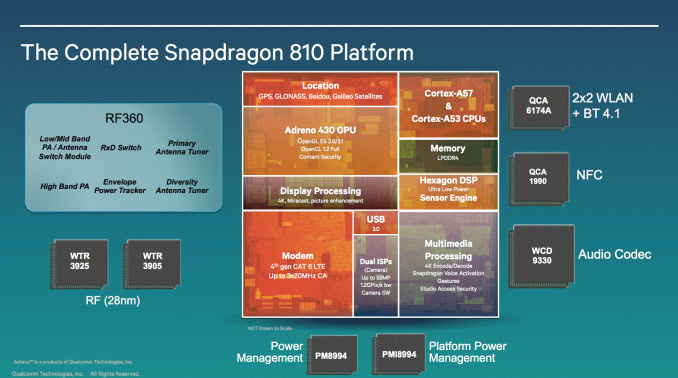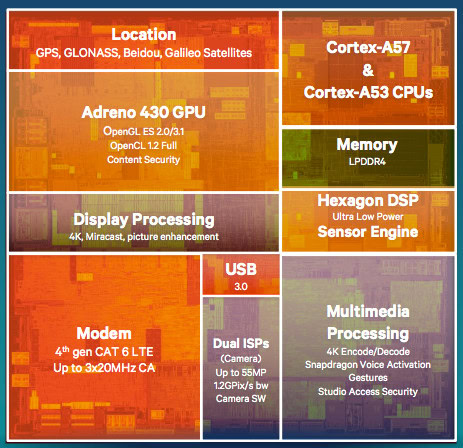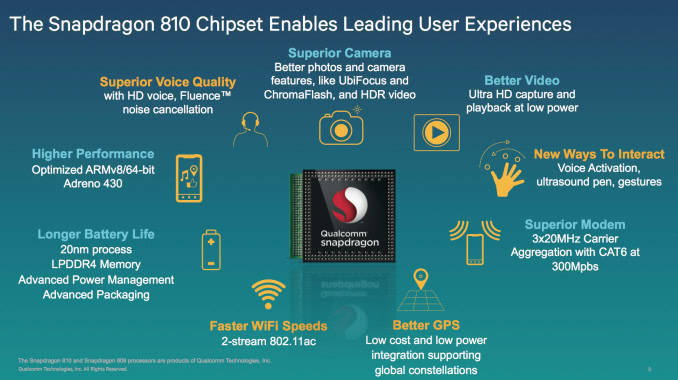Affiliate links on Android Authority may earn us a commission. Learn more.
Snapdragon 808 and 810 unveiled: 20-nm, 64-bit beasts coming early next year
April 7, 2014

Qualcomm just lifted the veil on the systems-on-a-chip that will power the wave of Android flagships coming in 2015.
The new Snapdragon 808 and Snapdragon 810 will be leaps and bounds ahead of the current crop of high-end Snapdragon SoCs, in almost all areas, including architecture, core number, GPU, and features. Qualcomm uncharacteristically released details of the new 808 and 810 very early, which is probably an answer to the moves of competitors like MediaTek and NVIDIA, as well as to Apple’s surprise jump to 64-bit on the iPhone 5S.
Snapdragon 810
The Qualcomm Snapdragon 810 (MSM8994) is the higher-end of the pair, a successor of sorts to the Snapdragon 805, which will only become available starting this summer. Main features of the 810 include:
- CPU: 4 Cortex A57 cores + 4 Cortex A53 cores (octo-core, big.LITTLE arrangement)
- ISA: 32-bit/64-bit ARM v8-A, 20nm
- GPU: Adreno 430
- Memory bandwidth: 64-bit LPDDR4-1600
- LTE: Cat 6/7 LTE, built-in
- eMMC interface: 5.0
- Wi-Fi: no (requires separate Wi-Fi module)
- Camera ISP: 14-bit dual-ISP
- H.256 encode/decode: yes/yes
Snapdragon 808
The Qualcomm Snapdragon 808 MSM8992 differs from the 810 through several features, mainly a different core arrangement and slightly slower GPU and memory interface. Here’s the breakdown:
- CPU: 2 Cortex A57 cores + 4 Cortex A53 cores (hexa-core, big.LITTLE arrangement)
- ISA: 32-bit/64-bit ARM v8-A, 20nm
- GPU: Adreno 418
- Memory bandwidth: 64-bit LPDDR4-933
- LTE: Cat 6/7 LTE, built-in
- eMMC interface: 5.0
- Wi-Fi: no (requires separate Wi-Fi module)
- Camera ISP: 12-bit dual-ISP
- H.256 encode/decode: no/yes
What kind of performance and features can we expect?
The bulk of the processing tasks in both the 808 and the 810 will be handled by the two, and respectively four, Cortex A57 CPU cores, combined in a big.LITTLE setup with four Cortex A53 cores. In a big.LITTLE arrangement, the two clusters of cores can operate together for maximum performance, or only one of them can run, depending on the task. On the 810 and 808, all cores in a cluster run at the same frequency.
The Cortex A57 provides a 25 – 55 percent performance boost over the Cortex A15, along with a 20 percent increase in power draw. However, because the 810 and 808 will be built on a 20nm process, instead of 28nm on current SoCs, power consumption should be offset overall.

With the Snapdragon 808 and 810, Qualcomm adopted a standard ARM architecture, instead of its Krait cores; the company will probably unveil Krait chips later in the year.
The Adreno 418 GPU on the Snapdragon 808 should provide a 20 percent performance boost over the Adreno 330 in the Snapdragon 801 (currently used on the Galaxy S5, HTCOne M8, etc.). The Adreno 430 GPU on the 810 is even faster, with an estimated 80 percent increase over Snapdragon 801.

Thanks to built-in hardware, both chips will be able to decode (play) video in the H.265 codec, but only the higher-end 810 will be able to encode (shoot in) H.265 encoding. The Snapdragon 805, due this summer, only offers H.265 video decoding.
The incorporated LTE modem (built on 20nm as well) will offer improved carrier aggregation, allowing up to three segments of spectrum to be used together for higher transfer speeds, compared to two segments on the current chips.
Finally, phones equipped with the Snapdragon 808/810 will be able to make real time image calculations faster than the current crop, thanks to the improved ISP throughput, which is 20 percent larger on the 810 compared with the current 805.
Some of the features you see listed in the image above, such as gestures support, ultrasound pen support, and Ultra HD capture and playback will be available on Snapdragon 805 devices, as the recently released development platform tablet shows.
As for precisely when we can expect this new class of SoCs from Qualcomm, AnandTech estimates there will be roughly a year between the Snapdragon 801 (released in late February at MWC) and the Snapdragon 810, while the Snapdragon 808 will follow soon after.